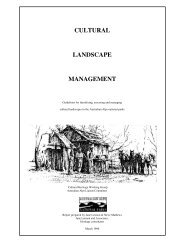Proceedings of an International Year of Mountains - Australian Alps ...
Proceedings of an International Year of Mountains - Australian Alps ...
Proceedings of an International Year of Mountains - Australian Alps ...
Create successful ePaper yourself
Turn your PDF publications into a flip-book with our unique Google optimized e-Paper software.
Inappropriate activities, not<br />
in keeping with achieving<br />
conservation <strong>of</strong> the alpine area<br />
created <strong>an</strong>d promoted by the<br />
tourism industry. The alpine<br />
area is not a recreational theme<br />
park.<br />
End<strong>an</strong>gered species<br />
impacts<br />
Large numbers <strong>of</strong> visitors<br />
walking in a dispersed m<strong>an</strong>ner<br />
in the confined area <strong>of</strong> the<br />
alpine area at peak times.<br />
Includes damage to the most<br />
vulnerable feldmark pl<strong>an</strong>t<br />
communities.<br />
Marketing<br />
Preferential marketing <strong>of</strong> the summit <strong>of</strong><br />
Mt Kosciusko <strong>an</strong>d alpine area by<br />
tourism org<strong>an</strong>isations: ‘the highest<br />
mountain on the continent’.<br />
Tourism impacts:<br />
Pl<strong>an</strong>ning<br />
considerations for<br />
the alpine area<br />
Growth<br />
Steady growth in visitor<br />
use, with excess numbers<br />
in peak periods.<br />
Weed impacts<br />
Spread <strong>of</strong> weeds into<br />
disturb<strong>an</strong>ce niches,<br />
affecting the alpine area.<br />
Soil impacts<br />
Impacts in the alpine area<br />
through site soil<br />
compaction, vegetation<br />
loss, degradation <strong>of</strong><br />
catchments, <strong>an</strong>d soil<br />
erosion.<br />
Proliferation <strong>of</strong> tracks<br />
Creation <strong>of</strong> secondary tracks:<br />
to remn<strong>an</strong>t snow patches <strong>an</strong>d<br />
lookout sites, despite requests<br />
for visitors to remain on<br />
primary tracks.<br />
Figure 5. Tourism pl<strong>an</strong>ning<br />
considerations for the Kosciuszko<br />
alpine area: direct <strong>an</strong>d indirect<br />
impacts.<br />
Pollution <strong>of</strong> water <strong>an</strong>d soils<br />
Impacts at high visitor use areas, through<br />
urine (high nitrogen values) <strong>an</strong>d<br />
introduction <strong>an</strong>d spread <strong>of</strong> Giardia <strong>an</strong>d<br />
Cryptospiridium from faeces, despite toilet<br />
facilities <strong>an</strong>d educational information.<br />
Habitat impacts<br />
Impacts on specialised<br />
habitats in the alpine area<br />
<strong>an</strong>d loss <strong>of</strong> endemic <strong>an</strong>d<br />
end<strong>an</strong>gered flora species<br />
through trampling <strong>an</strong>d<br />
disturb<strong>an</strong>ce.<br />
Sustainable visitor use<br />
Achieving the m<strong>an</strong>agement <strong>of</strong><br />
visitor numbers within the<br />
capacity <strong>of</strong> the <strong>of</strong>ficial walking<br />
track system <strong>an</strong>d destinations for<br />
<strong>an</strong>y given day.<br />
Scenery protection<br />
M<strong>an</strong>agement has a special<br />
responsibility to continue to<br />
rehabilitate past damage to<br />
natural scenic l<strong>an</strong>dscapes.<br />
Research <strong>an</strong>d adaptive<br />
m<strong>an</strong>agement<br />
M<strong>an</strong>agement needs to<br />
respond to issues such as<br />
visitor use pressures.<br />
Researchers, <strong>an</strong>d<br />
m<strong>an</strong>agement, working<br />
together on the<br />
implementation <strong>of</strong> adaptive<br />
m<strong>an</strong>agement practices <strong>an</strong>d<br />
monitoring, will facilitate<br />
environmentally sustainable<br />
tourism<br />
Rehabilitation<br />
Rehabilitation works need to<br />
continue.<br />
Figure 6. M<strong>an</strong>agement<br />
challenges <strong>of</strong> the next 20 years<br />
for the Kosciuszko alpine area.<br />
Vision<br />
M<strong>an</strong>aging to conserve<br />
<strong>an</strong>d protect the<br />
natural <strong>an</strong>d cultural<br />
heritage <strong>of</strong> the<br />
Kosciuszko alpine area<br />
Weeds<br />
Weeds are a real threat to the integrity<br />
<strong>of</strong> the Alpine Area. They are occupying<br />
disturbed sites <strong>an</strong>d have not yet<br />
achieved their ecological potential.<br />
M<strong>an</strong>agement disturb<strong>an</strong>ce <strong>an</strong>d visitor use<br />
disturb<strong>an</strong>ce are two key agents <strong>of</strong> weed<br />
dispersal.<br />
Soil erosion<br />
Some 20 years after the finish<br />
<strong>of</strong> the Soil Conservation<br />
Works, further soil<br />
stabilisation works are<br />
required to fix the old works.<br />
New erosion problems need to<br />
be addressed.<br />
Ski tourism<br />
encroachments<br />
Pressures for further<br />
encroachment <strong>of</strong> the alpine<br />
area by the ski industry may<br />
arise as global warming limits<br />
snow extent <strong>an</strong>d duration.<br />
132<br />
Celebrating <strong>Mountains</strong> – An <strong>International</strong> <strong>Year</strong> <strong>of</strong> <strong>Mountains</strong> Conference<br />
Jindabyne, New South Wales, Australia

















